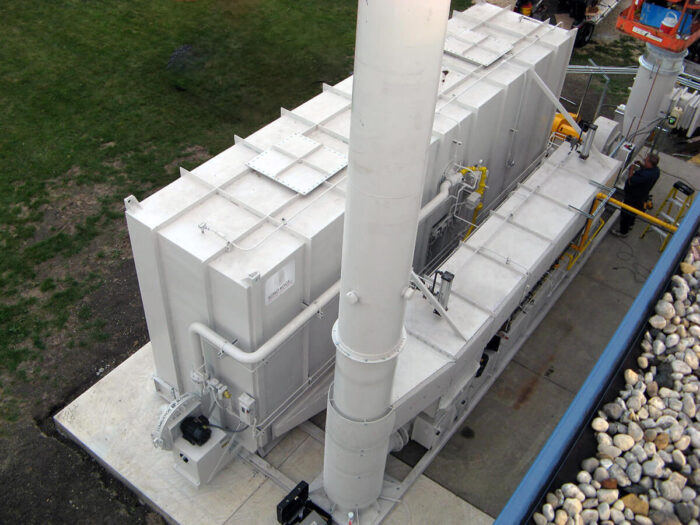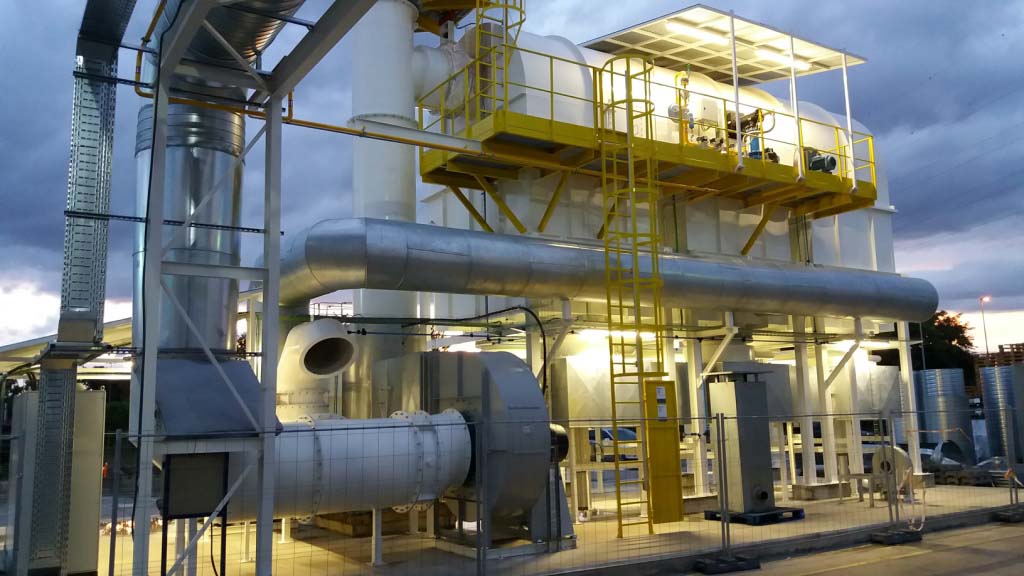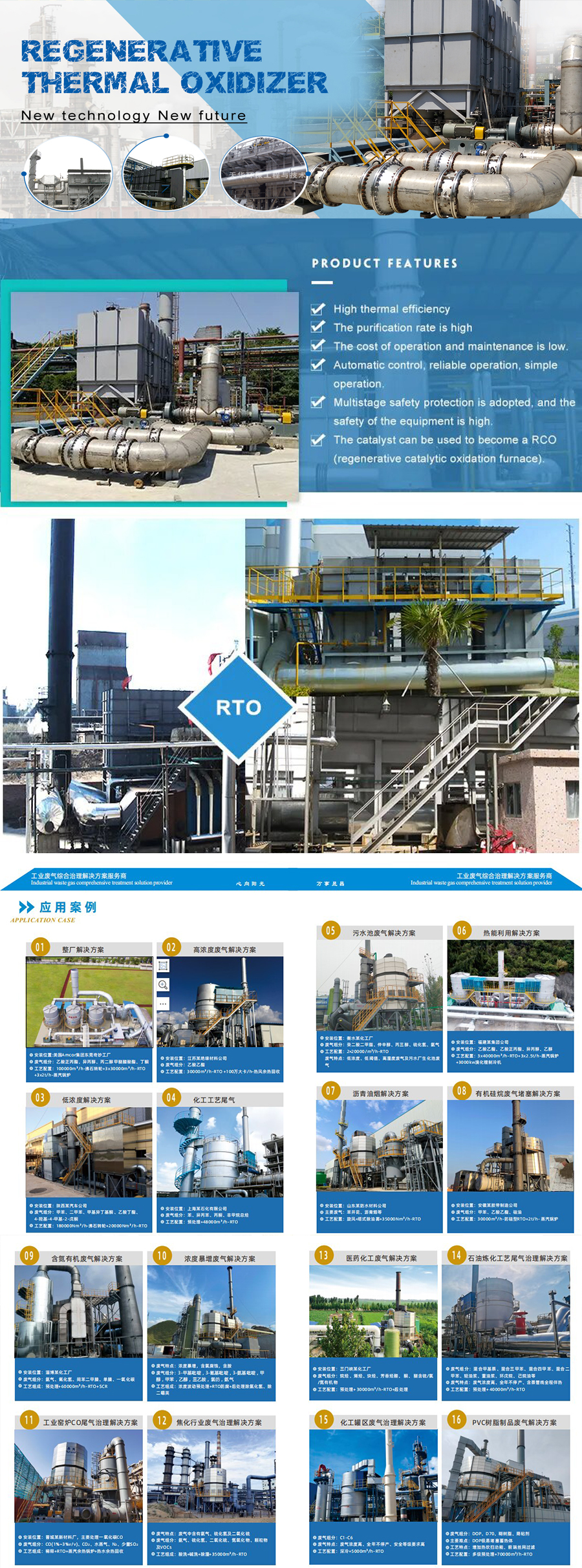Informações básicas.
Modelo NO.
RTO incrível
Tipo
Incinerador
Economia de energia
100
Fácil de operar
100
Alta eficiência
100
Menos manutenção
100
Marca registrada
Fantástico
Pacote de transporte
Madeira no exterior
Especificação
180*24
Origem
China
Código HS
8416100000
Descrição do produto
RTO
Oxidador térmico regenerativo
Compared with traditional catalytic combustion,; direct thermal oxidizer,; RTO has the merits of high heating efficiency,; low operation cost,; and the ability to treat large flux low concentration waste gas.; When VOCs concentration is high,; secondary heat recycle can be realized,; which will greatly reduce the operation cost.; Because RTO can preheat the waste gas by levels through ceramic heat accumulator,; which could make the waste gas to be completely heated and cracked with no dead corner(treatment efficiency>99%);,;which reduce the NOX in the Exhausting gas,; if the VOC density >1500mg/Nm3,; when the waste gas reach cracking area,; it has been heated up to cracking temperature by heat accumulator,; the burner will be closed under this condition.;
RTO can be devided into chamber type and rotary type according to difference operation mode.; Rotary type RTO has advantages in system pressure,; temperature stability,; investment amount,; etc
| Tipos de RTO | Eficiência | Mudança de pressão (mmAq); | Tamanho | (max);Treatment volume | |
| Eficiência do tratamento | Eficiência de reciclagem de calor | ||||
| Tipo rotativo RTO | 99 % | 97 % | 0-4 | small(1 time); | 50000Nm3/h |
| RTO do tipo três câmaras | 99 % | 97 % | 0-10 | Grande (1.;5times); | 100000Nm3/h |
| Tipo de duas câmaras RTO | 95 % | 95 % | 0-20 | middle(1.;2times); | 100000Nm3/h |
Regenerative Thermal Oxidizer,; Regenerative Thermal Oxidizer,; Regenerative Thermal Oxidizer,; Thermal Oxidizer,; Thermal Oxidizer,; Thermal Oxidizer,; oxidizer,; oxidizer,; oxidizer,; incinerator,; incinerator,; incinerator,; waste gas treatment,; waste gas treatment,; waste gas treatment,; VOC treatment,; VOC treatment,; VOC treatment,; RTO,; RTO,; RTO,; RTO,; RTO,; RTO
Endereço: 8 floor, E1, Pinwei building, Dishengxi road, Yizhuang, ZheJiang, China
Tipo de negócio: Fabricante/fábrica, empresa comercial
Gama de negócios: Eletroeletrônicos, equipamentos e componentes industriais, máquinas de fabricação e processamento, metalurgia, minerais e energia
Certificação do sistema de gerenciamento: ISO 9001, ISO 14001
Principais produtos: Rto, linha de revestimento colorido, linha de galvanização, faca de ar, peças sobressalentes para linha de processamento, revestidor, equipamentos independentes, rolo de pia, projeto de renovação, soprador
Apresentação da empresa: A ZheJiang Amazing Science & Technology Co., Ltd é uma próspera empresa de alta tecnologia, localizada na Área de Desenvolvimento Econômico e Tecnológico de ZheJiang (BDA). Seguindo o conceito de realista, inovadora, focada e eficiente, nossa empresa atende principalmente ao setor de tratamento de gases residuais (VOCs) e a equipamentos metalúrgicos da China e até mesmo do mundo todo. Possuímos tecnologia avançada e vasta experiência em projetos de tratamento de gases residuais de VOCs, cuja referência foi aplicada com sucesso no setor de revestimento, borracha, eletrônicos, impressão, etc. Também temos anos de acúmulo de tecnologia na pesquisa e fabricação de linhas de processamento de aço plano e temos quase 100 exemplos de aplicação.
Nossa empresa tem como foco a pesquisa, o projeto, a fabricação, a instalação e o comissionamento do sistema de tratamento de gás residual orgânico de VOCs e o projeto de renovação e atualização para economia de energia e proteção ambiental da linha de processamento de aço plano. Podemos oferecer aos clientes soluções completas para proteção ambiental, economia de energia, melhoria da qualidade do produto e outros aspectos.
Também estamos envolvidos em várias peças sobressalentes e equipamentos independentes para a linha de revestimento colorido, linha de galvanização, linha de decapagem, como rolo, acoplador, trocador de calor, recuperador, faca de ar, soprador, soldador, nivelador de tensão, passe de pele, junta de expansão, tesoura, juntadeira, costurador, queimador, tubo radiante, motor de engrenagem, redutor, etc.

Qual é o custo da instalação de um oxidante térmico regenerativo?
O custo de instalação de um oxidador térmico regenerativo (RTO) pode variar significativamente, dependendo de vários fatores. Esses fatores incluem o tamanho e a capacidade do RTO, os requisitos específicos da aplicação, as condições do local e qualquer personalização ou engenharia adicional necessária. No entanto, é importante observar que os RTOs geralmente são considerados um investimento de capital significativo devido ao seu projeto complexo e aos recursos de alto desempenho.
Aqui estão algumas considerações de custo associadas à instalação de um RTO:
- Tamanho e capacidade da RTO: O tamanho e a capacidade da RTO, normalmente medidos em termos de taxa de fluxo de escape e concentração de poluentes, são fatores de custo importantes. As RTOs maiores, capazes de lidar com maiores volumes de escapamento e concentrações de poluentes, geralmente têm custos iniciais mais altos em comparação com as unidades menores.
- Engenharia e personalização: Os requisitos de engenharia e personalização para integrar a RTO ao processo industrial existente podem afetar o custo de instalação. Isso inclui fatores como modificações nos dutos, conexões elétricas e qualquer integração de processo necessária para garantir o funcionamento adequado da RTO no sistema geral.
- Preparação do local: O local onde a RTO será instalada pode exigir preparação para acomodar o equipamento. Isso pode envolver a construção de fundações, o fornecimento de espaço adequado para a RTO e os componentes associados e a garantia de acesso adequado para instalação e manutenção.
- Sistemas e equipamentos auxiliares: Além da própria RTO, pode haver sistemas e equipamentos auxiliares necessários para uma operação eficaz. Isso pode incluir sistemas de pré-tratamento, como depuradores ou filtros, unidades de recuperação de calor, sistemas de monitoramento e controle e equipamentos de monitoramento de emissões de chaminés. O custo desses componentes adicionais deve ser considerado no custo total da instalação.
- Mão de obra e equipamentos de instalação: O custo da mão de obra e dos equipamentos necessários para o processo de instalação, incluindo serviços de guindaste e empreiteiros especializados, deve ser considerado no custo total. A complexidade da instalação e quaisquer desafios específicos do local podem influenciar esses custos.
- Licenças e conformidade: A obtenção das licenças necessárias e a conformidade com os requisitos regulatórios podem envolver custos adicionais. Isso inclui taxas para licenças ambientais, estudos de engenharia, testes de emissões e documentação de conformidade.
Devido às muitas variáveis envolvidas, é um desafio fornecer uma faixa de custo específica para a instalação de uma RTO. Recomenda-se consultar fabricantes de RTOs ou empresas de engenharia de boa reputação, que podem avaliar os requisitos específicos da aplicação e fornecer estimativas de custo detalhadas com base no escopo do projeto.

Are regenerative thermal oxidizers safe to operate?
Regenerative thermal oxidizers (RTOs) are designed with safety considerations to ensure their safe operation. When properly installed, operated, and maintained, RTOs provide a high level of safety. Here are some key points regarding the safety of operating RTOs:
- Combustion and Fire Safety: RTOs are designed to safely combust and destroy volatile organic compounds (VOCs) and other pollutants in the exhaust stream. They incorporate various safety features to prevent the risk of uncontrolled fires or explosions. These features may include flame arrestors, temperature sensors, pressure relief devices, and automated shutdown systems to ensure safe operation in the event of abnormal operating conditions.
- Control and Monitoring Systems: RTOs are equipped with advanced control and monitoring systems that continuously monitor various parameters such as temperature, pressure, and flow rates. These systems provide real-time data to operators, allowing them to detect any deviations from normal operating conditions promptly. Alarms and safety interlocks are often included to alert operators and initiate appropriate actions in case of abnormal situations.
- Heat Recovery and Thermal Efficiency: RTOs are designed to maximize thermal efficiency by recovering and reusing heat generated during the oxidization process. This reduces the overall energy consumption and minimizes the risk of heat buildup within the system, contributing to safe operation and preventing excessive temperatures that could pose safety hazards.
- Equipment and Material Selection: RTOs are constructed using materials that can withstand the high temperatures and corrosive conditions encountered during operation. Heat-resistant materials, such as ceramic beds or metallic heat exchangers, are commonly used. Proper material selection ensures the integrity and longevity of the equipment, reducing the risk of failures or leaks that could compromise safety.
- Compliance with Standards and Regulations: RTOs must comply with applicable safety standards and regulations. These standards define specific requirements for the design, installation, operation, and maintenance of air pollution control systems, including RTOs. Compliance with these standards ensures that the RTOs meet the necessary safety criteria and helps safeguard the health and well-being of personnel and the surrounding environment.
- Operator Training and Maintenance: Adequate operator training and regular maintenance are crucial for safe RTO operation. Operators should receive comprehensive training on the system’s operation, safety procedures, and emergency response protocols. Additionally, routine maintenance and inspections help identify and address any potential safety concerns or equipment issues before they escalate.
While RTOs are generally safe to operate, it is essential to follow the manufacturer’s guidelines, maintain proper safety protocols, and adhere to applicable regulations to ensure safe and reliable operation.

How efficient are regenerative thermal oxidizers in destroying volatile organic compounds (VOCs)?
Regenerative thermal oxidizers (RTOs) are highly efficient in destroying volatile organic compounds (VOCs) emitted from industrial processes. Here are the reasons why RTOs are considered efficient in VOC destruction:
1. Alta eficiência de destruição: RTOs are known for their high destruction efficiency, typically exceeding 99%. They effectively oxidize VOCs present in the industrial exhaust streams, converting them into less harmful byproducts, such as carbon dioxide and water vapor. This high destruction efficiency ensures that the majority of VOCs are eliminated, resulting in cleaner emissions and compliance with environmental regulations.
2. Residence Time: RTOs provide a sufficiently long residence time for the combustion of VOCs. In the RTO chamber, the VOC-laden air is directed through a ceramic media bed, which acts as a heat sink. The VOCs are heated to the combustion temperature and react with the available oxygen, leading to their destruction. The design of RTOs ensures that the VOCs have ample time to undergo complete combustion before being released into the atmosphere.
3. Temperature Control: RTOs maintain the combustion temperature within a specific range to optimize VOC destruction. The operating temperature is carefully controlled based on factors such as the type of VOCs, their concentration, and the specific requirements of the industrial process. By controlling the temperature, RTOs ensure that the VOCs are efficiently oxidized, maximizing destruction efficiency while minimizing the formation of harmful byproducts, such as nitrogen oxides (NOx).
4. Recuperação de calor: RTOs incorporate a regenerative heat recovery system, which enhances their overall energy efficiency. The system captures and preheats the incoming process air by utilizing the heat energy from the outgoing exhaust stream. This heat recovery mechanism minimizes the amount of external fuel required to sustain the combustion temperature, resulting in energy savings and cost-effectiveness. The heat recovery also helps maintain the high destruction efficiency of VOCs by providing a consistent and optimized operating temperature.
5. Catalyst Integration: In some cases, RTOs can be equipped with catalyst beds to further enhance VOC destruction efficiency. Catalysts can accelerate the oxidation process and lower the required operating temperature, improving the overall efficiency of VOC destruction. Catalyst integration is particularly beneficial for processes with lower VOC concentrations or when specific VOCs require lower temperatures for effective oxidation.
6. Compliance with Regulations: The high destruction efficiency of RTOs ensures compliance with environmental regulations governing VOC emissions. Many industrial sectors are subject to stringent air quality standards and emission limits. RTOs provide an effective solution for meeting these requirements by reliably and efficiently destroying VOCs, reducing their impact on air quality and public health.
In summary, regenerative thermal oxidizers (RTOs) are highly efficient in destroying volatile organic compounds (VOCs). Their high destruction efficiency, residence time, temperature control, heat recovery capabilities, optional catalyst integration, and compliance with regulations make RTOs a preferred choice for industries seeking effective and sustainable solutions for VOC abatement.

editor by Dream 2024-11-27
